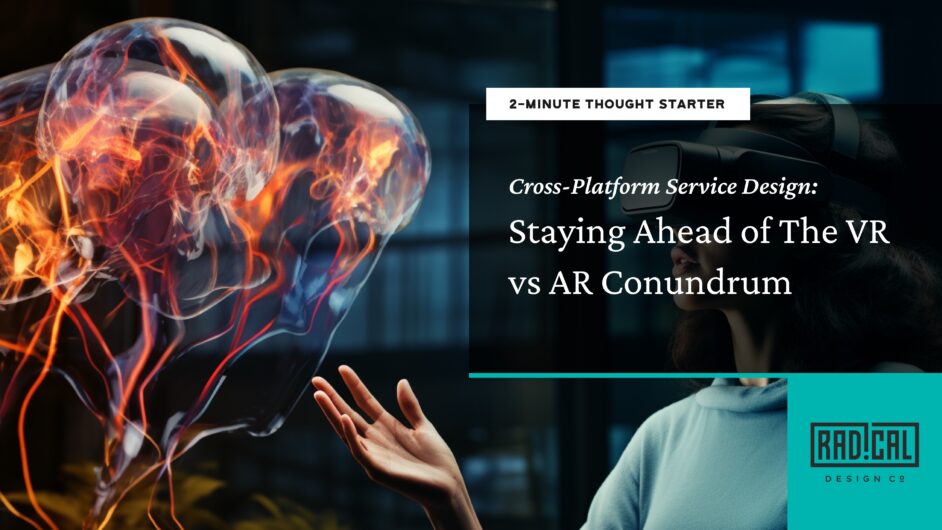Cross-Platform Service Design: Staying Ahead of the VR vs. AR Conundrum
Discover the perfect blend of VR & AR in service design. Unlock enhanced user experiences by merging immersive & augmented realities.

In the ever-evolving digital space, VR (Virtual Reality) and AR (Augmented Reality) are transforming the landscape of immersive experiences. Apple, Meta, and more are going all-in on different ways to command virtual experience. While some customer-facing organizations find themselves in a quandary of choosing between the two, we propose a more integrated approach where VR and AR are not competitors but collaborators in creating enriched user experiences.
In a world where the digital landscape is as dynamic as the users it serves, the intertwining of VR and AR under a holistic service design strategy isn’t just an option—it’s a necessity for staying ahead of the curve.
Here’s an in-depth exploration of strategies to achieve this seamless integration:
-
Platform Versatility
It’s tempting to hinge your bets on VR or AR, but the pioneering strategy lies in an integrated platform. A design harmonizing VR and AR components ensures a broader reach and enhanced engagement. For instance, consider a retail app that employs AR for virtual try-ons and VR for a fully immersive virtual store experience. Such a setup accommodates diverse user preferences and needs, ensuring a universal appeal.
Use Case Example: A retailer introduces a mobile application with Augmented Reality (AR) and Virtual Reality (VR). With AR, shoppers can visualize products in their actual settings, such as placing furniture or trying on clothes virtually. For an even more immersive shopping experience, they can switch to VR Mode, where they can stroll through a virtual store, examine products in detail, and even watch a fashion show as if they were present. This dual technology fulfills both practical and experiential shopping requirements, resulting in more user engagement and increased sales.
-
Context-Driven Approach
The nature and context of the interaction should dictate the choice between VR and AR. AR can bring learning materials to life for educational content, making complex concepts more accessible. However, VR might be the better choice for an immersive learning module where distraction-free focus is vital. In the near future, especially with the introduction of Meta Quest 3 and the Apple Vision Pro, enterprises will experiment with immersive technologies for consumer and enterprise use, making the context-driven approach integral to meeting diverse needs.
Use Case Example: Museum visitors can utilize an augmented reality (AR) application to enhance their experience with exhibits. They can access detailed information and animated visualizations by pointing their devices at artifacts. However, users can wear virtual reality (VR) headsets for a unique exhibit about ancient civilizations, allowing them to fully immerse themselves in a reconstructed ancient city and explore it as if they were physically present. The museum chooses the technology based on each exhibit’s desired level of engagement and educational experience.
-
Seamless Transitions
The user journey should be fluid between VR and AR, with each technology stepping in when best suited. Imagine a real estate app; users can utilize AR to visualize furniture in a property and then switch to VR to explore a detailed, immersive home view. This level of interaction can boost engagement rates.
Use Case Example: A real estate company develops a mixed-reality app that lets potential buyers view properties virtually. Using augmented reality (AR), buyers can add virtual furniture and see design changes. They can then switch to virtual reality (VR) to explore the property in a fully immersive 3D environment, including every room and feature, smoothly providing a complete and comfortable property viewing experience from a buyer’s home.
-
Future-Proof Design
With technology evolving at breakneck speed, adaptability is critical. Your design should be efficient and elastic, ready to morph and adapt to the influx of innovations in VR, AR, and even the burgeoning field of Mixed Reality (MR). Incorporating open APIs, modular design structures, and adaptable UX/UI designs ensures your platform remains relevant and engaging.
Use Case Example: A company specializing in educational technology creates a learning platform that can adapt to new and emerging technologies. At first, it supports AR for interactive textbooks and VR for virtual labs. As Mixed Reality (MR) becomes more popular, the platform can grow to include MR features, which allow students to interact with 3D holograms and manipulate them during their learning sessions, ultimately enhancing student engagement and comprehension without requiring a complete overhaul of the existing system.
-
User-Centric Design
Every nuance of the design should echo the preferences and needs of the end-user. User experience is one of the top growth catalysts in AR/VR. A retail app might lean more toward AR for real-time product visualization, while a gaming app might immerse players in a VR world for a more engulfing experience. User feedback, analytics, and behavioral data should guide the implementation of VR and AR elements.
Use Case Example: A health and fitness gym utilizes virtual reality (VR) to offer engaging workout experiences. At the same time, they can use augmented reality (AR) technology to create more real-world engagement and social interaction during in-house workout routines. Depending on their preferences and location needs, gymgoers can pick between a fully immersive VR workout or an augmented, interactive, real-world exercise experience.
Intrigued?
More Thought Starters

Thought Starters
The Art & Science of Design: Striking the Perfect Balance between Beauty and Functionality

Thought Starters
A Design Strategy Perspective: Crafting Corporate Policies for AI Use

Thought Starters